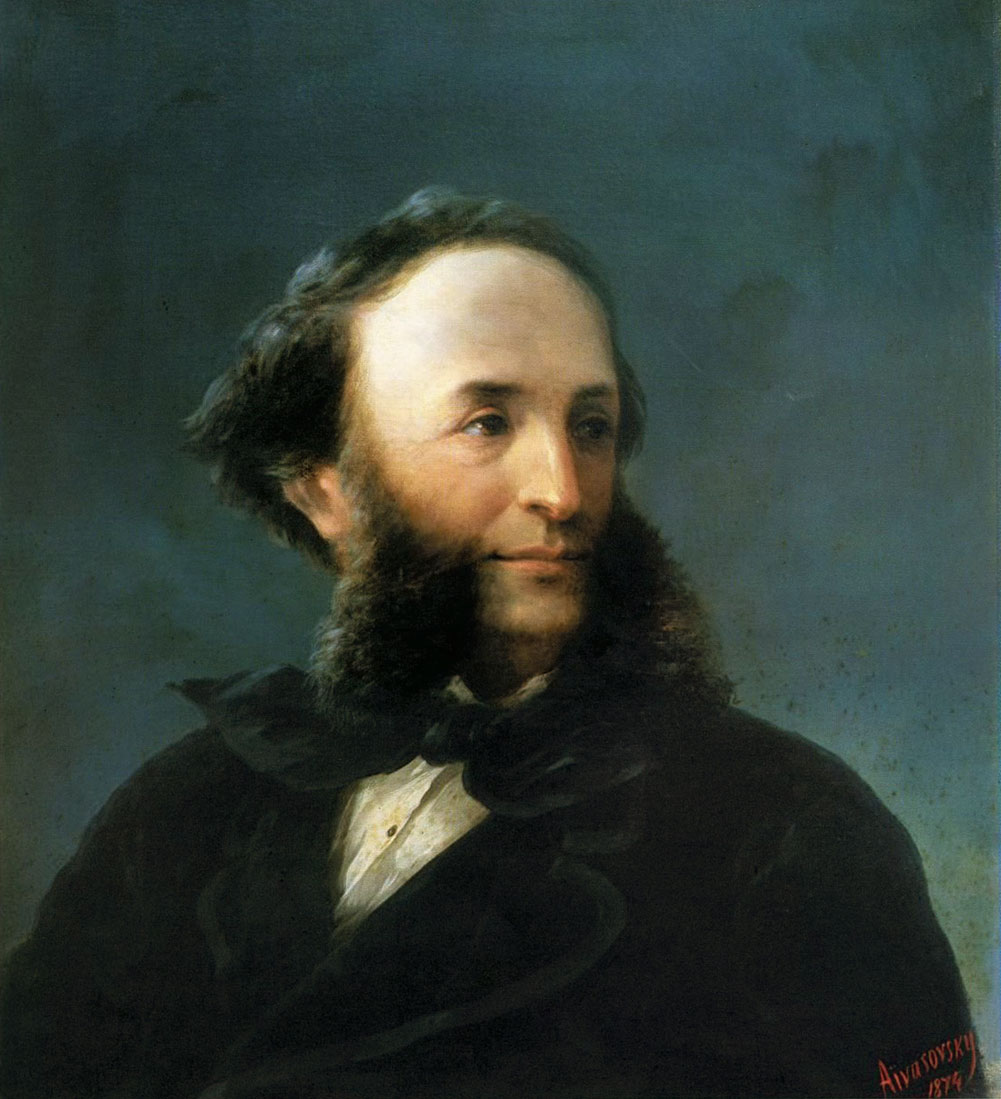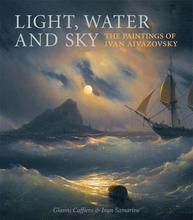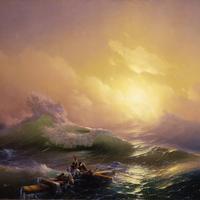More about Ivan Ayvazovsky
- All
- Info
- Shop
Works by Ivan Ayvazovsky

Contributor
Ivan Konstantinovich Aivazovsky, Ива́н Константи́нович Айвазо́вский, was baptized into an Armenian Orthodox family as Hovhannes Aivazian.
While studying in Italy, he began using a Russian version of his name, Gaivazovsky, before eventually becoming Aivazovsky. In his late 20s, he became popular with the Russian monarchy, but declined a lucrative invitation to become a court painter, turning away from the role accepted by Giuseppe Arcimboldo, Diego Velazquez, and Anthony van Dyck.
The artist was born in Feodosia, a Crimean town on the Black Sea which is, as of 2019, legally part of Ukraine but de facto controlled by Russia. For centuries the town had been defined by its relationship to the ocean, the major focus of Aivozovsky's work: as the 14th century Moroccan scholar Ibn Battutah wrote of Feodosia, "we saw a wonderful harbor with about two hundred vessels in it, both ships of war and trading vessels, small and large, for it is one of the world's celebrated ports." However, by Aivazovsky's time a war had devastated the town, and a subsequent plague, just five years before Aivazovsky's birth, had removed nearly every trace of culture and commerce from Feodosia. "In old drawings, we see on the site of the once-rich city piles of ruins with barely visible traces of deserted streets and individual surviving houses." The Aivazovsky house, set in an elevated location on the outskirts of the city, offered the young artist a terrace with a wide panorama of the beautiful gulf landscape set against the ruins and vestiges of an ancient, once flourishing civilization.
At the age of twenty-one, Aivazovsky enrolled in the landscape art class of Professor M.N. Vorobyov in St. Petersburg, having impressed the school with his drawings. Receiving silver and gold medals from the Czarist government, he returned to Crimea to do his first major studies of the sea, including Moonlit Night in Gurzuf and Sea Coast, influenced by the work of S.F. Shchedrin and the landscapes of his teacher M.N. Vorobyov. From 1839-45, he traveled with the Russian navy and worked in Italy, making a series of brilliant works showing the relationship between sunlight, moonlight, and the behavior of the ocean. The Czar's navy made him the honorary Artist of the Naval Staff and permitted him to wear a uniform. Aivazovsky later decided to travel on his own, visiting many European cities, Egypt, and, at the age of eighty, the United States.
Sources
- Айвазовский, Иван Константинович. Издательство "Искусство", Москва, 1965 год.
- Ангаладян, Рубен. 'И. К. АЙВАЗОВСКИЙ. МИР КАК ВЕТЕР С МОРЯ Текст научной статьи по специальности «Общие и комплексные проблемы естественных и точных наук».' КиберЛенинка: https://cyberleninka.ru/article/n/i-k-ayvazovskiy-mir-kak-veter-s-morya.
- Ibn Batuttah. The Travels of Ibn Battutah. London: Picador, 2002.
- ПОЛИЩУК, Наталия, Лариса КОЛЕСНИЧЕНКО. "Айвазовский и Одесса." Дерибасовская–Ришельевская: Одесский альманах/сост.: ФД Кохрихт, ЕМ Голубовский, ОИ Губарь. (Одесса: Печатный дом, 2007): 219-228.
- ty-doctor.ru, "И.К. Айвазовский." Via Google Scholar: https://scholar.google.com/scholar?hl=en&as_sdt=0%2C22&q=%D0%98.%D0%9A….
- Жарков, Евгений. "Айвазовский об Александре Иванове: Неизвестное интервью художника." Сучасні проблеми дослідження, реставрації та збереження культурної спадщини (2010): 70-81.
Featured Content
Here is what Wikipedia says about Ivan Aivazovsky


Ivan Konstantinovich Aivazovsky (Russian: Иван Константинович Айвазовский; 29 July [O.S. 17 July] 1817 – 2 May [O.S. 19 April] 1900) was a Russian Romantic painter who is considered one of the greatest masters of marine art. Baptized as Hovhannes Aivazian, he was born to Armenian parents in the Black Sea port of Feodosia in Crimea and was mostly based there.
Following his education at the Imperial Academy of Arts in Saint Petersburg, Aivazovsky traveled to Europe and lived briefly in Italy in the early 1840s. He then returned to Russia and was appointed the main painter of the Russian Navy. Aivazovsky had close ties with the military and political elite of the Russian Empire and often attended military maneuvers. He was sponsored by the state and was well-regarded during his lifetime. The saying "worthy of Aivazovsky's brush", popularized by Anton Chekhov, was used in Russia for describing something lovely. He remains highly popular in Russia in the 21st century.
One of the most prominent Russian artists of his time, Aivazovsky was also popular outside the Russian Empire. He held numerous solo exhibitions in Europe and the United States. During his almost 60-year career, he created around 6,000 paintings, making him one of the most prolific artists of his time. The vast majority of his works are seascapes, but he often depicted battle scenes, Armenian themes, and portraiture. Most of Aivazovsky's works are kept in Russian, Ukrainian, Armenian, and Turkish museums as well as private collections.
Check out the full Wikipedia article about Ivan Aivazovsky












